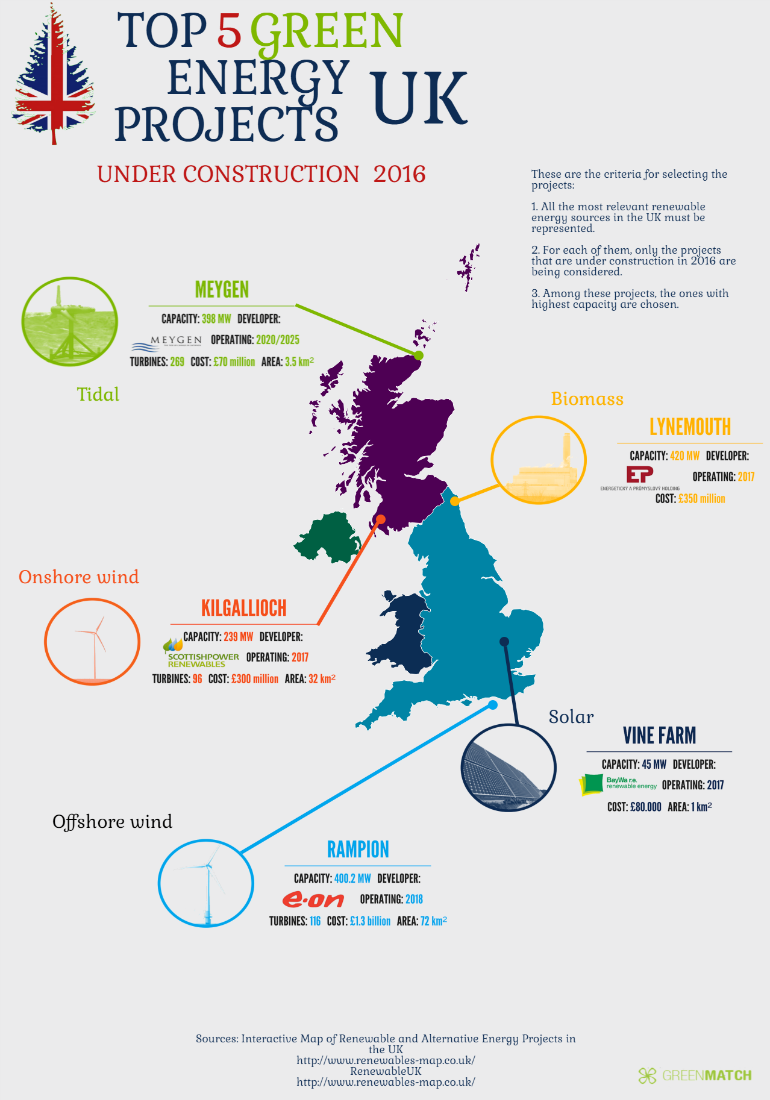Answer these simple questions and we will find you the BEST prices
Which type of solar quotes do you need?
It only takes 30 seconds
100% free with no obligation

Get up to 4 quotes from our selected suppliers by filling in only 1 form

Save money by comparing quotes and choosing the most competitive offer

Our service is 100% free and with no obligation
- GreenMatch
- Blog
- Top 5 Renewable Energy Projects Under Construction in the UK in 2016
Top 5 Renewable Energy Projects Under Construction in the UK in 2016
Infographic Showing the Main Features of the Projects

The UK energy market has just started to experience a shift towards renewable energy sources. This trend has been promoted by the binding carbon targets and the EU’s 2020 renewable energy targets for the UK. In this context, some green energy projects are already operating, others are under construction, and many more planned in the UK.
Our aim, at Greenmatch.co.uk, in this post is to give an overview of the current development of green energy projects.
The following are the green energy projects under construction in the UK in 2016 with the highest capacity of their category:
German renewable energy company BayWa r.e. has built solar and wind parks in the UK that, combined, have a total capacity of 260 MW. Now it’s building the Vine Farm solar (photovoltaics) park in South Cambridgeshire, which will be the largest solar project of BayWa r.e. with a capacity of 45 MW. Its budget is £80.000 and its area will be 250 acres (approximately 100 hectares). Construction began in 2015 and, taking into account its size, it’ll be completed probably before 2017.
Lynemouth Power Station, located in Northumberland coast, was a coal power plant from 1972 to 2015. It was sold from German energy giant RWE to Czech utility company EPH. During 2016 and the first months of 2017, it’ll be converted into a biomass power plant. The conversion process will cost £350 million and will allow Lynemouth Power Station to generate 420 MW of electricity from burning wood pellets.
Among the large amount of wind energy projects being built in Scotland thanks to its natural conditions and politic and business willingness, Kilgallioch Windfarm will have the larger capacity (for onshore wind), being able to provide up to 239 MW when operating. Scottish Power Renewables is developing this wind farm project in Dumfries and Galloway County, Scotland. It’s estimated it’ll be completed in 2017, and it’ll require a construction expense of £300 million. It will consist of 96 Gamesa turbines (with a maximum size of 146.5 m to blade tip) laid out in a 32 km² area.
E.ON is currently constructing an offshore wind farm in the English Channel, 13 km off the coast of Sussex. When completed, it’ll be visible from Brighton and will have a capacity of 400.2 MW. Its 116 turbines provided by Vestas will have a total height of 140 m. The wind farm will cover an area of 72 km² after spending £1.3 billion.
Although tidal and wave energy are different energy sources and the technologies employed to harvest them is different, they’re usually combined under the same category (ocean energy), since they share many characteristics. The ocean energy project under construction with the highest planned capacity is the MeyGen tidal energy project (398 MW). It’s located in the Inner Sound of the Pentland Firth, a body of water between the north Scottish mainland and Stroma Island. Its 269 turbines laid out in 3.5 km² will be operating by the early 2020s. The total cost of the project will be £70 million.
Feel free to share the infographic and resize it!
We strive to connect our customers with the right product and supplier. Would you like to be part of GreenMatch?




